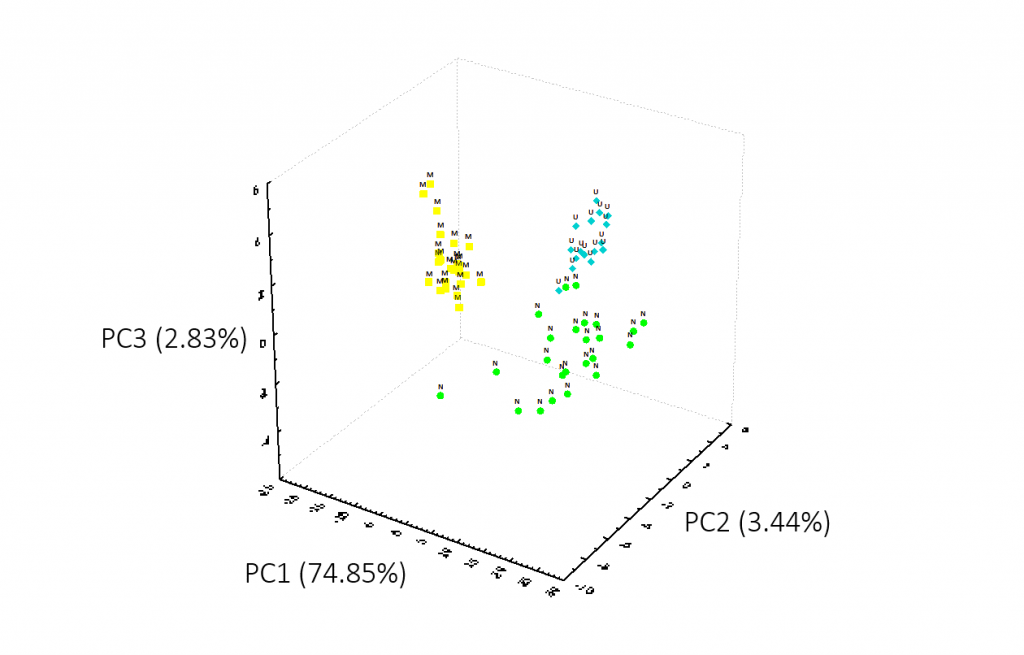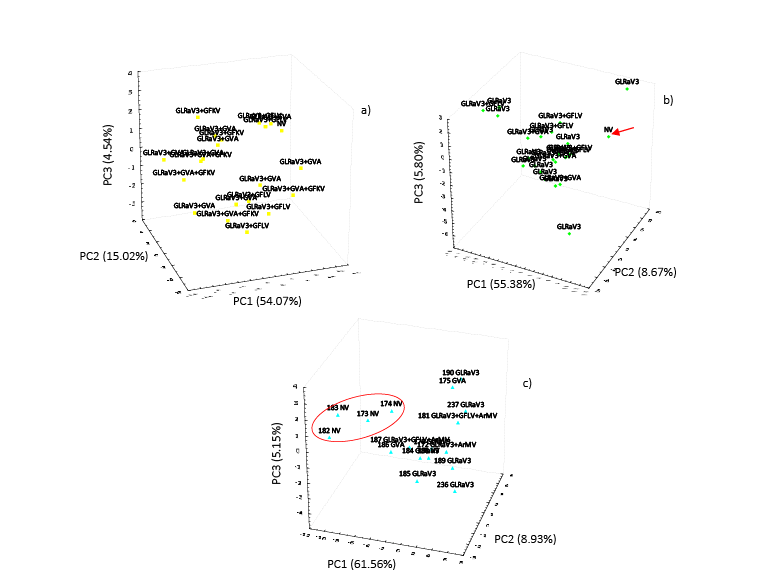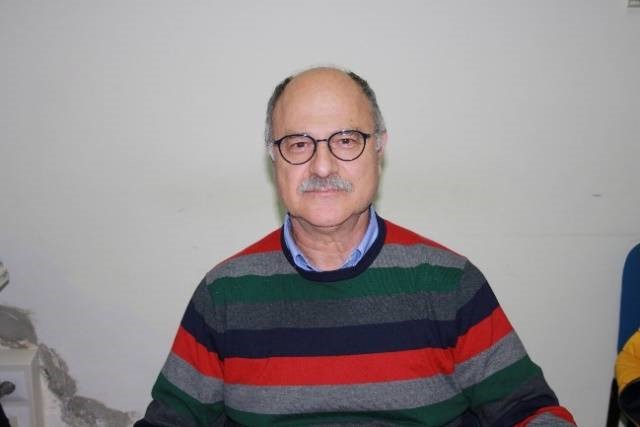By Pasquale Crupi, Marica Gasparro, Angelo Raffaele Caputo
The level of secondary metabolites in grapes mainly depends on cultivar type, but also on climate and growing conditions, including the sanitary status (Crupi et al. 2012; Coletta et al. 2014; Popovic-Djordjevic et al. 2017; Lakićević et al. 2018). Indeed, Grapevine leafroll associated virus (GLRaV) and Grapevine virus A (GVA), for instance, may reduce the rate of photosynthesis and, consequently, affect the overall quality of grapes and musts (Endeshaw et al. 2014; Alabi et al. 2016); although, they have showed a controversy effect on the biosynthesis of secondary metabolites (i.e. polyphenols) (Guīă and Buciumeanu 2016; Mannini and Digiaro 2017).
The goal of this study was to employ a metabolomic fingerprinting approach (through flow injection MS QqQ analyses) in order to group 71 wine grapes biotypes, belonging to three Apulian autochthonous varieties (i.e. Negro amaro, Malvasia Nera di Brindisi/Lecce, and Uva di Troia) on the basis of cultivar and virus complexes (such as, GLRaV3, GVA, GFLV, and GFKV), by which they are, eventually, infected. Therefore, the skins of Negro amaro (22), Malvasia Nera di Brindisi/Lecce (32), and Uva di Troia (17), whose identity was confirmed by genomic DNA microsatellites profiles, were extracted through a solution of water/ethanol/hydrochloric acid (70:30:1, v/v/v) and analyzed by means of a G6430 QqQ MS device (Agilent Technologies) in positive full scan mode and in 100-700 m/z range. The obtained [M+H]+ abundances were processed by logarithmic transformation and autoscaling, thereby they were subjected to a statistic multivariate tool (PCA). As reported in Figure 1, PCA allowed to distinguish Malvasia Nera (M) biotypes from Negramaro (N) and Uva di Troia (U), especially thanks to ions at m/z 115, 143, 261, 409, 445, and 561 which have the highest loadings (> 0.95) on PC1. Conversely, N and U were only slightly separated by the less determinant PC2 and PC3.

The clusterization of the biotypes affected by different virus complexes was really more tough (Figure 2); indeed, a clear distinction among infected plants was not observed, even though, very interesting, healthy grapes were sharply separated in the case of N and U (Figure 2b and c). Finally, from gathered findings the proposed metabolomic approach could be used as a rapid method for screening varietal and, less evidently, sanitary difference between grape biotypes.
Those interested in a longer length report can download the working paper at:
https://www.tandfonline.com/doi/abs/10.1080/14786419.2019.1586703


Pasquale Crupi is a Research Scientist at CREA-VE, Council for Agricultural Research and Economics – Viticulture and Enology, Italy. His research is mainly focused on chemical characterization of metabolites in food matrices. From 2007 to 2013 he was member of Italian delegation to the International Organisation of Vine and Wine (OIV). From 2006 he is a Lecturer for many post-graduate courses. He is the author of more than 100 publications.
Dr. Crupi was educated in Chemistry at University of Bari (Italy). He received a Ph.D. in Biotechnologies of Food Products in 2008 at University of Foggia (Italy).

Gasparro Marica is a Researcher at CREA-VE, Council for Agricultural Research and Economics – Viticulture and Enology, Italy. Her research is mainly focused on virological analysis for the diagnosis of the main grapevine viruses; analysis of gene expression in nutrigenomic studies for the evaluation of the effects of grape intake on human health; molecular characterization of grapevine germplasm for varietal identification and study of relationships.
Dr.ssa Gasparro is graduated in Biological Sciences in 2005, at University of Bari (Italy) and she attended a postgraduate course in Biology of nutrition.

Angelo Raffaele Caputo is a scientific Technologist at Council for Agricultural Research and Economics, Research Centre for Viticulture and Enology, Italy. His scientific activity is mainly focused on safeguarding and enhancing viticultural biodiversity for implementation sustainable viticultural practices. From 2005 to 2012 he was a CREA delegate official and member of the Operative Secretariat of the National Service Coordination of the Vine Certification. From 2016 he was appointed Expert in the field of research and innovation in the ‘table and wine grapes’ sector – ‘wine agri-food processing’ by the Ministry of Agricultural Food, Forestry, and Tourism Policies (Italy). He is the author of numerous publications (more than 100) and projects coordinator.
Dr. Caputo got his Degree cum laude in Agricultural Sciences at the University of Bari (Italy) in 1987. In 1988 he qualified as an agronomist.
References
- Alabi OJ, Casassa LF, Gutha LR, Larsen RC, Henick-Kling T, Harbertson JF, Naidu RA. 2016. Impacts of grapevine leafroll disease on fruit yield and grape and wine chemistry in a wine grape (Vitis vinifera L.) cultivar. Plos One. 11(2):e0149666.
- Coletta A, Berto S, Crupi P, Cravero MC, Tamborra P, Antonacci D, Daniele PG, Prenesti E. 2014. Effect of viticulture practices on concentration of polyphenolic compounds and total antioxidant capacity of Southern Italy red wines. Food Chem. 152:467–874.
- Crupi P, Coletta A, Milella RA, Perniola R, Gasparro M, Genghi R, Antonacci D. 2012. HPLC-DAD ESI-MS analysis of flavonoid compounds in 5 seedless table grapes grown in Apulian region. J Food Sci. 77(2):C174–C181.
- Endeshaw ST, Sabbatini P, Romanazzi G, Schilder AC, Neri D. 2014. Effects of grapevine leafroll associated virus 3 infection on growth, leaf gas exchange, yield and basic fruit chemistry of Vitis vinifera L. cv. Cabernet Franc. Scientia Hortic. 170:228–236.
- Guīă IC, Buciumeanu EC. 2016. Effect of virus infection on grape quality and quantity (Vitis vinifera L., cv. Fetească neagră). Afr J Agric Sci Technol. 4:806–811.
Lakićević SH, Popović-Djordjević J, Pejin B, Djordjević A, Matijăsevic S, Lazic ML. 2018. An insight into chemical composition and bioactivity of ‘Prokupac’ red wine. Nat Prod Res. - Mannini F, Digiaro M. 2017. The effects of viruses and viral diseases on grapes and wine. In: Meng B, Martelli G, Golino D, Fuchs M, editors. Grapevine viruses: molecular biology, diagnostics and management. Cham (Switzerland): Springer.
- Popovic-Djordjevic J, Pejin B, Dramicanin A, Jovic S, Vujovic D, Zunic D, Ristic R. 2017. Wine chemical composition and radical scavenging activity of some cabernet franc clones. Curr Pharm Biotechnol. 18(4):343–350.

